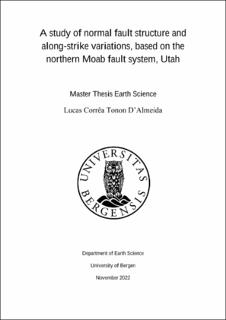| dc.description.abstract | Fault systems are complex structures where multiple elements generate a network that can deeply impact fluid flow, affecting subsurface hydrocarbon and groundwater reservoirs. However, seismic data from such structures are hampered by data resolution, while field mapping, where much more details are seen, faces the challenge of outcrop quality and abundance. In this work, I combined these two data sources, a series of canyons that cut through a fault splay belonging to the Moab Fault system in southern Utah, USA, and large-scale fault systems found in the North Sea rift, to evaluate how seismic data resolution can influence our perception of fault complexity. As many variables control how fault systems are imaged in seismic surveys, it is important to understand how different parameters impact structural imaging to avoid pitfalls. By generating models based on the Utah outcrops, it was possible to produce seismic equivalents and then use a 2D Point Spread Function-based convolution method of modelling to assess how the models would be seismically imaged. As seismic imagery is also affected by many parameters like Dominant frequency, Angle of illumination, Critical angle and Noise, during the modelling, these were modified to different values to verify their impact in the imaging of fault structures. The images generated in this study demonstrate how challenging it can be to properly image and interpret small displacement faults and associated structures. The detectability of normal faults and their structures depends mostly on the size of the displacement and the reflectivity between the units juxtaposed by the fault. Concerning seismic parameters affecting fault visibility, the dominant frequency and illumination are two of the most important. The first allows for the observation of smaller structures the higher it becomes. The second parameter points to whether a surface will be illuminated in the seismic. However, the illumination parameter may be of little use in real normal fault seismic images, as most structures have a dip angle higher than the maximum illumination angle found in seismic surveys. Other parameters, like the incident angle and noise, tend to reduce the visibility of structures in fault zones, so they should always be as low as possible. In comparing the synthetic seismic produced here with the real one, it was noticed that many low displacement faults could appear as small “bumps” or anticlines that could be mistaken by drag structures. This problem can sometimes be solved by moving the image along strike as the change in the displacement may become enough to make the fault visible. | |
